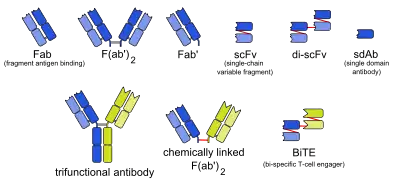In molecular biology, an intrabody (from intracellular and antibody) is an antibody that works within the cell to bind to an intracellular protein.[1] Due to the lack of a reliable mechanism for bringing antibodies into a living cell from the extracellular environment, this typically requires the expression of the antibody within the target cell, which can be accomplished in transgenic animals[2] or by gene therapy. As a result, intrabodies are defined as antibodies that have been modified for intracellular localization, and the term has rapidly come to be used even when antibodies are produced in prokaryotes or other non-target cells.[3] This term can apply to several types of protein targeting: the antibody may remain in the cytoplasm, or it may have a nuclear localization signal,[4] or it may undergo cotranslational translocation across the membrane into the lumen of the endoplasmic reticulum, provided that it is retained in that compartment through a KDEL sequence.[5]
Because naturally occurring antibodies are optimised to be secreted from the cell, cytosolic intrabodies require special alterations, including the use of single-chain antibodies (scFvs), modification of immunoglobulin VL domains for hyperstability,[6] selection of antibodies resistant to the more reducing cytosolic environment,[7] or expression as a fusion protein with maltose binding protein or other stable intracellular proteins.[8] Such optimizations have improved the stability and structure of intrabodies, allowing the publication of a variety of promising applications against hepatitis B,[9] avian influenza,[10] prion diseases,[11] inflammation,[12] Parkinson's disease,[13] and Huntington's disease.[14] Optimizations required for cytosolic intrabodies are not needed for ER retained intrabodies, which fold in the compartment in which antibodies are naturally produced. Since the 1990s ER intrabodies have been used in various research areas to knock down membrane proteins and secreted proteins. [15]
References
- ↑ Chen, SY; Bagley, J; Marasco, WA (1994). "Intracellular antibodies as a new class of therapeutic molecules for gene therapy". Human Gene Therapy. 5 (5): 595–601. doi:10.1089/hum.1994.5.5-595. PMID 7914435.
- ↑ Marschall, AL; Single, FN; Schlarmann, K; Bosio, A; Strebe, N; van den Heuvel, J; Frenzel, A; Dübel, S (2014). "Functional knock down of VCAM1 in mice mediated by endoplasmatic reticulum retained intrabodies". mAbs. 6 (6): 1394–401. doi:10.4161/mabs.34377. PMC 4622715. PMID 25484057.
- ↑ Cohen, PA; Mani, JC; Lane, DP (1998). "Characterization of a new intrabody directed against the N-terminal region of human p53". Oncogene. 17 (19): 2445–56. doi:10.1038/sj.onc.1202190. PMID 9824155.
- ↑ Mhashilkar, AM; Bagley, J; Chen, SY; Szilvay, AM; Helland, DG; Marasco, WA (1995). "Inhibition of HIV-1 Tat-mediated LTR transactivation and HIV-1 infection by anti-Tat single chain intrabodies". The EMBO Journal. 14 (7): 1542–51. doi:10.1002/j.1460-2075.1995.tb07140.x. PMC 398241. PMID 7537216.
- ↑ Yurong Yang Wheeler; Timothy E. Kute; Mark C. Willingham; Si-Yi Chen; David C. Sane (2003). "Intrabody-based strategies for inhibition of vascular endothelial growth factor receptor-2: effects on apoptosis, cell growth, and angiogenesis". The FASEB Journal. 17 (12): 1733–5. doi:10.1096/fj.02-0942fje. PMID 12958192.
- ↑ Cohen, PA; Mani, JC; Lane, DP (1998). "Characterization of a new intrabody directed against the N-terminal region of human p53". Oncogene. 17 (19): 2445–56. doi:10.1038/sj.onc.1202190. PMID 9824155.
- ↑ Auf Der Maur, A; Escher, D; Barberis, A (2001). "Antigen-independent selection of stable intracellular single-chain antibodies". FEBS Letters. 508 (3): 407–12. doi:10.1016/S0014-5793(01)03101-5. PMID 11728462.
- ↑ Shaki-Loewenstein, S; Zfania, R; Hyland, S; Wels, WS; Benhar, I (2005). "A universal strategy for stable intracellular antibodies". Journal of Immunological Methods. 303 (1–2): 19–39. doi:10.1016/j.jim.2005.05.004. PMID 16045924.
- ↑ Serruys, B; Van Houtte, F; Verbrugghe, P; Leroux-Roels, G; Vanlandschoot, P (2009). "Llama-derived single-domain intrabodies inhibit secretion of hepatitis B virions in mice". Hepatology. 49 (1): 39–49. doi:10.1002/hep.22609. PMID 19085971.
- ↑ Mukhtar, MM; Li, S; Li, W; Wan, T; Mu, Y; Wei, W; Kang, L; Rasool, ST; et al. (2009). "Single-chain intracellular antibodies inhibit influenza virus replication by disrupting interaction of proteins involved in viral replication and transcription". The International Journal of Biochemistry & Cell Biology. 41 (3): 554–60. doi:10.1016/j.biocel.2008.07.001. PMID 18687409.
- ↑ Filesi, I; Cardinale, A; Mattei, S; Biocca, S (2007). "Selective re-routing of prion protein to proteasomes and alteration of its vesicular secretion prevent PrP(Sc) formation". Journal of Neurochemistry. 101 (6): 1516–26. doi:10.1111/j.1471-4159.2006.04439.x. PMID 17542810.
- ↑ Strebe, N; Guse, A; Schüngel, M; Schirrmann, T; Hafner, M; Jostock, T; Hust, M; Müller, W; Dübel, S (2009). "Functional knockdown of VCAM-1 at the posttranslational level with ER retained antibodies". Journal of Immunological Methods. 341 (1–2): 30–40. doi:10.1016/j.jim.2008.10.012. PMID 19038261.
- ↑ Zhou, C; Przedborski, S (2009). "Intrabody and Parkinson's disease". Biochimica et Biophysica Acta (BBA) - Molecular Basis of Disease. 1792 (7): 634–42. doi:10.1016/j.bbadis.2008.09.001. PMC 2745095. PMID 18834937.
- ↑ Cardinale, A; Biocca, S (2008). "The potential of intracellular antibodies for therapeutic targeting of protein-misfolding diseases". Trends in Molecular Medicine. 14 (9): 373–80. doi:10.1016/j.molmed.2008.07.004. PMID 18693139.
- ↑ Marschall, AL; Dübel, S; Böldicke, T (2015). "Specific in vivo knockdown of protein function by intrabodies". mAbs. 7 (6): 1010–35. doi:10.1080/19420862.2015.1076601. PMC 4966517. PMID 26252565.
